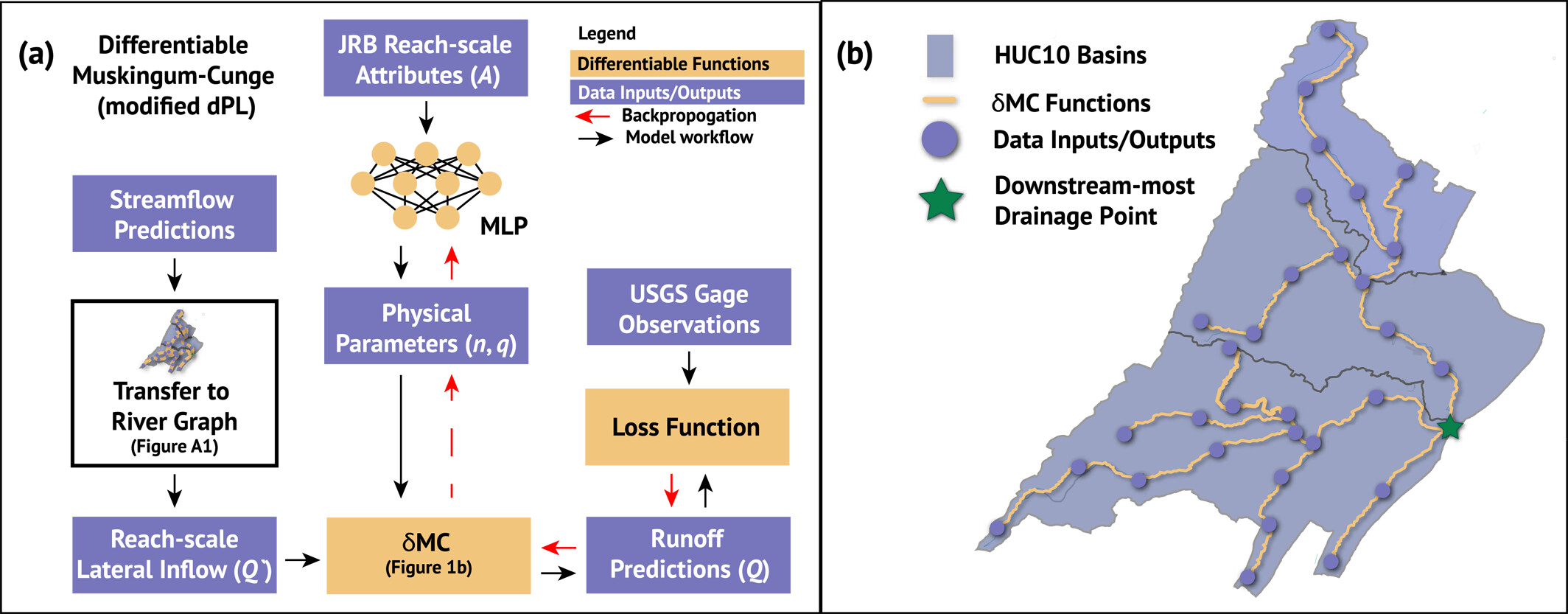\(\delta\) MC-Juniata-hydroDL2¶

Code Release¶
Below are Zenodo releases for:
Check out the code on Github here
Summary¶
A novel differentiable modeling framework to perform routing and to learn a “parameterization scheme” (a systematic way of inferring parameters from more rudimentary information) for routing flows on the river network.
Below are the main points from our paper:
- A novel differentiable routing model can learn effective river routing parameterization, recovering channel roughness in synthetic runs.
- With short periods of real training data, we can improve streamflow in large rivers compared to models not considering routing.
- For basins >2,000 km2, our framework outperformed deep learning models that assume homogeneity, despite bias in the runoff forcings.
Bibtex Citation¶
@article{https://doi.org/10.1029/2023WR035337,
author = {Bindas, Tadd and Tsai, Wen-Ping and Liu, Jiangtao and Rahmani, Farshid and Feng, Dapeng and Bian, Yuchen and Lawson, Kathryn and Shen, Chaopeng},
title = {Improving River Routing Using a Differentiable Muskingum-Cunge Model and Physics-Informed Machine Learning},
journal = {Water Resources Research},
volume = {60},
number = {1},
pages = {e2023WR035337},
keywords = {flood, routing, deep learning, physics-informed machine learning, Manning's roughness},
doi = {https://doi.org/10.1029/2023WR035337},
url = {https://agupubs.onlinelibrary.wiley.com/doi/abs/10.1029/2023WR035337},
eprint = {https://agupubs.onlinelibrary.wiley.com/doi/pdf/10.1029/2023WR035337},
note = {e2023WR035337 2023WR035337},
abstract = {Abstract Recently, rainfall-runoff simulations in small headwater basins have been improved by methodological advances such as deep neural networks (NNs) and hybrid physics-NN models—particularly, a genre called differentiable modeling that intermingles NNs with physics to learn relationships between variables. However, hydrologic routing simulations, necessary for simulating floods in stem rivers downstream of large heterogeneous basins, had not yet benefited from these advances and it was unclear if the routing process could be improved via coupled NNs. We present a novel differentiable routing method (δMC-Juniata-hydroDL2) that mimics the classical Muskingum-Cunge routing model over a river network but embeds an NN to infer parameterizations for Manning's roughness (n) and channel geometries from raw reach-scale attributes like catchment areas and sinuosity. The NN was trained solely on downstream hydrographs. Synthetic experiments show that while the channel geometry parameter was unidentifiable, n can be identified with moderate precision. With real-world data, the trained differentiable routing model produced more accurate long-term routing results for both the training gage and untrained inner gages for larger subbasins (>2,000 km2) than either a machine learning model assuming homogeneity, or simply using the sum of runoff from subbasins. The n parameterization trained on short periods gave high performance in other periods, despite significant errors in runoff inputs. The learned n pattern was consistent with literature expectations, demonstrating the framework's potential for knowledge discovery, but the absolute values can vary depending on training periods. The trained n parameterization can be coupled with traditional models to improve national-scale hydrologic flood simulations.},
year = {2024}
}